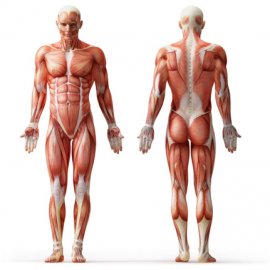
 If you’re a guy in the gym working with weights, not only are you probably trying to lose some fat, but also gain some muscle.
If you’re a guy in the gym working with weights, not only are you probably trying to lose some fat, but also gain some muscle.
This article discusses the mechanisms of how muscles grow, plus why most women won’t gain large amounts of muscle when working with weights.
Although there are different types of muscles, such as cardiac muscle (your heart), for our concerns, we will talk exclusively about skeletal muscles. Skeletal muscle is composed of thread-like myofibrils and sarcomeres that form a muscle fiber and are the basic units of contraction.
The 650 skeletal muscles in the human body contract when they receive signals from motor neurons, which are triggered from a part of the cell called the sarcoplasmic reticulum. Motor neurons tell your muscles to contract and the better you become at having those signals tell your muscles to contract, the stronger you can get.
When someone like a powerlifter is able to lift very heavy weight despite not looking very muscular, it’s due to their ability to activate those motor neurons and contract their muscles better. This is why some powerlifters can be relatively smaller compared to bodybuilders, but can lift significantly more weight. Motor Unit recruitment also helps to explain why, after practice, certain movements become easier to perform and most of the initial strength gains will be when you first start to lift weights. Muscle growth tends to occur more steadily after this initial period of strength gain because you are more easily able to activate the muscles.
The Physiology Of Muscle Growth
After you workout, your body repairs or replaces damaged muscle fibers through a cellular process where it fuses muscle fibers together to form new muscle protein strands or myofibrils. These repaired myofibrils increase in thickness and number to create muscle hypertrophy (growth). Muscle growth occurs whenever the rate of muscle protein synthesis is greater than the rate of muscle protein breakdown. This adaption, however, does not happen while you actually lift the weights. Instead, it occurs while you rest.
So how do you actually add muscle to your muscle cells? This is where Satellite cells come in and act like stem cells for your muscles. When activated, they help to add more nuclie to the muscle cells and therefore contribute directly to the growth of myofibrils (muscle cells). Activating these satellite cells may be the difference between what allows certain “genetic freaks” to grow massive muscles and what makes other people “hard-gainers.”
In one of the most interesting studies in the past 5 years, researchers showed that those who were “extreme responders” to muscle growth, with an incredible 58% myofiber hypertrophy from an exercise, had 23% activation of their satellite cells. Modest responders, who had a 28% growth, had 19% activation of their satellite cells. What is interesting to note, though, is that some people known as “non-responders” in the study had 0% growth and had a concurrent 0% activation of their satellite cells. Therefore, it seems the more you can activate these satellite cells, the more you’ll be able to grow. So then the question becomes, how do you activate these satellite cells to increase muscle growth?
3 Mechanisms That Make Muscles Grow
Underlying all progression of natural muscle growth is the ability to continually put more stress on the muscles. This stress is a major component involved in the growth of a muscle and disrupts homeostasis within your body. The stress and subsequent disruption in homeostasis causes three main mechanisms that spur on muscle growth.
Muscle Growth Mechanism #1: Muscle Tension
In order to produce muscle growth, you have to apply a load of stress greater than what your body or muscles had previously adapted too. How do you do this? The main way is to lift progressively heavier weights. This additional tension on the muscle helps to cause changes in the chemistry of the muscle, allowing for growth factors that include mTOR activation and satellite cell activation.
Muscular tension also most dramatically effects the connection of the motor units with the muscle cells. Two other factors help to explain why some people can be stronger, but not as big as other people.
Muscle Growth Mechanism #2: Muscle Damage
If you’ve ever felt sore after a workout, you have experienced the localized muscle damage from working out. This local muscle damage causes a release of inflammatory molecules and immune system cells that activate satellite cells to jump into action. This doesn’t mean that you have to feel sore in order for this to happen, but instead that the damage from the workout has to be present in your muscle cells. Typically soreness is attenuated over time by other mechanisms.
Muscle Growth Mechanism #3: Metabolic Stress
If you’ve ever felt the burn of an exercise or had the “pump” in the gym, then you’ve felt the effects of metabolic stress. Scientists used to question bodybuilders when they said the “pump” caused their muscles to become larger. After more investigation, it seems as though they were onto something.
Metabolic stress causes cell swelling around the muscle, which helps to contribute to muscle growth without necessarily increasing the size of the muscle cells. This is from the addition of muscle glycogen, which helps to swell the muscle along with connective tissue growth. This type of growth is known as sarcoplasmic hypertrophy and is one of the ways that people can get the appearance of larger muscles without increases in strength.
So now that you know the three main mechanisms of muscle growth, the next question is: how do hormones affect muscle growth?
How Do Hormones Affect How Muscles Grow?
Hormones are another component largely responsible for muscle growth and repair because of their role in regulating satellite cell activity. Insulin Growth Factor (IGF)-1, in particular Mecho-Growth Factor (MGF) and testosterone are the two most vital mechanisms that promote muscle growth.
Testosterone is the main hormone that most people think about when working out with weights, and there seems to be some validity to the thought that testosterone increases protein synthesis, inhibits protein breakdown, activates satellite cells, and stimulates other anabolic hormones. Although most testosterone is bound in the body and therefore not available to use (up to 98%), strength training seems to help not only release more testosterone, but also make the receptors of your muscle cells more sensitive to your free testosterone. Testosterone can also stimulate growth hormone responses by increasing the presence of neurotransmitters at the damaged fiber site, which can help to activate tissue growth.
The IGF regulates the amount of muscle mass growth by enhancing protein synthesis, facilitating glucose uptake, repartitioning the uptake of amino acids (the building blocks of protein) into skeletal muscles and once again, activates satellite cells to increase muscle growth.
INTERESTING VIDEO












